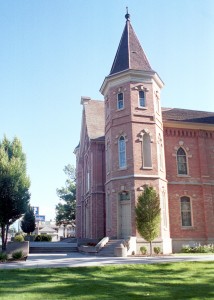Elder Jeffrey R. Holland will preside at the groundbreaking for the Provo City Center Temple on Saturday. The new temple will be built on the site where the Provo Tabernacle once stood.
The groundbreaking for the new temple is scheduled for May 12 at 9 a.m. Tickets are required to attend the ceremony and are available from LDS ecclesiastical leaders in the temple’s new district. The ceremony will also be broadcast to stake centers around Provo.

People who are new to the Provo area often drive by the corner of Center Street and University Avenue where they can see the burnt remains of the building’s framework, without knowing the majesty and grandeur of the Provo Tabernacle and its rich history.
In 1881, plans were first made to erect a new larger tabernacle because the LDS community was outgrowing their old meeting house. The projected cost was $50,000 with a two-year plan to build.
Construction of the Provo Tabernacle began in 1883 and was completed three years later. The building wasn’t dedicated until nearly 12 years after its completion on Dec. 8, 1898, by LDS Church President George Q. Cannon. Before the tabernacle burned down on Dec. 17, 2010, it was used for many civic events, choir performances, graduations and worship services.
Provo Mayor John Curtis said he feels the tabernacle was a place which bound the community together — a lasting piece of history that seemed to be an important part of the city.
“If you had asked me a week ago if a building could actually have a heart beat, I think I would have laughed,” Curtis said.” Yet somehow, in an instant, all of us felt it, all of us saw it and all of us knew it. This was more than a building, this building had a soul. It was part of us, a part of our fabric and a part of who we are.”
Douglas Smoot, emeritus dean of engineering and technology at BYU, has felt a strong connection to the tabernacle ever since he was born. Douglas is the great-grandson of Abraham O. Smoot, who served 13 years as Provo mayor and as the first president of the board of trustee’s of Brigham Academy.
One of Abraham’s O. Smoot’s greatest undertakings was to build the Provo Tabernacle and in 1874 he got the deed to the land.
Smoot’s great-grandson said he remembers many memories he had while living close to the tabernacle.
“Sitting there in the tabernacle, either participating or speaking, was always a special experience for me,” Douglas said. “The sun on a nice day, which was often, would just pour through those beautiful stain glass windows on the south side. That has been a very long standing feeling of being in there and just a very sacred experience for me.”
Hundreds of thousands of people sat in the wood-carved benches of the tabernacle, listened to the many choirs, civic programs and heartfelt sermons from the pulpit. Students, parents, friends and neighbors gathered there to fellowship and commune with God.
“Perhaps even more important than these truly famous moments at the tabernacle,” said Matthew Holland, president of Utah Valley University, “are the thousands and thousands of quieter, but even more influential moments, which have positively shaped the lives of these good citizens of this fair valley of ours.”
Speaking at a community gathering in December of 2010, Holland paid tribute to the tabernacle and spoke of the many personal experiences he had while growing up near the tabernacle.
“The tabernacle has been the place of my sweetest moments of communion with believers not of my particular faith,” Holland said.
Many members of the Provo community have fond memories at the tabernacle, yet the image ingrained in so many minds as of late is the billowing columns of smoke coming from the roof of the once majestic building.
It took 36 hours of intense labor and roughly one million gallons of water to finally extinguish the flames on Dec. 18, 2010. The fire marshal said it was one of the largest fire investigations in the state.
Russell Bateman, a Provo resident, has dedicated many hours into preserving the history of the tabernacle recorded on the website provotabernacle.com.
“This building was the most important piece of architecture in this valley and I was devastated to see it burn,” Bateman said.
Though the fire brought much sorrow and heartache, the plans to build an LDS Temple renewed excitement for many church members.
“I was ecstatic when the church announced a new temple to be built in its place,” Smoot said. “Not only will the tabernacle be resurrected, it will also be exalted.”




